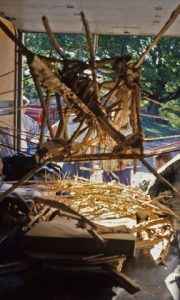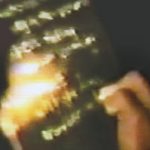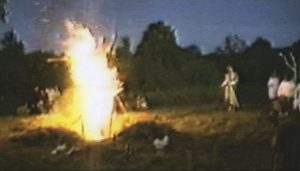On a sunny August day, I travelled out to a site about an hour away from Toronto, on the edge of the Niagara Escarpment, with a group of three friends and a large wooden structure, dismantled for transportation in the back of a truck. For a month or so, I had been in rehearsal with about twenty performers who would be arriving the next day and staying overnight before taking part in the event the following afternoon and evening.
I had undertaken the development of the structure and the performance throughout the previous year, with a goal to create a fire in the shape of a winged being, or angel. As the project developed, it gathered complex layers of imagery. Eventually there was a need to think about the event itself, and the project became performance as well as sculpture.
It was in the aftermath of the performance experience that I discovered a problem with the record of the event. As performance art, it was a type of experience accepted to be inarticulable. In the spectrum of human communication, there are good reasons to produce visual, tactile, and multimedia work, and leave them as such. People commonly say, “The work speaks for itself”.
Yet many of us experience famous works of art only through photographic or video records or linguistic testimony. I had produced an extensive visual and acoustic record of my event in the form of photos and videos.
“The record” was always an aspect of the performance. Participants had been invited to provide testimony about what they had “heard” at a certain point. “Scribes” were waiting at the entrances to the pathways that led away from the site, and they wrote in chalk on black wood panels as people listed what they had “heard”. During the performance, I had said that we would take this record “back to the city”.
The image content of the performance — an “apparition” variously presented as an “angel”, “tree”, “opening”, and “star” — alluded to Old Testament archetypes that had travelled through history in the cultural artistic record. The problem of “the record” is an old problem that once led to sacred books and vast artistic archives across cultures. The impulse to record is part of being human. We are driven to create signs of our inner experience of life.
The “record” of this performance event became an ongoing problem when I found that none of the photos or videos seemed adequate to capture my experience. It took some time for me to realize that part of the problem was the dualistic order implicit in the media, which recorded what had happened visually and acoustically. I was looking for a way of recording what had happened in the mind as well as the senses. I could not abandon the idea that there might be a way to create a record that would transport people to the world of the event. In other words, it would replicate and not just represent the experience.
I was aware that if I succeeded, I might have a way of replicating any experience.
This was my problem, and it was accompanied by a compelling sense that it was both worthwhile and possible.
In The Record—Mind, Matter, and What Happened in 1987, I document my process of discovery, the solution I accepted, and my exploration of its significance. I have articulated the form as “cognitive sculpture” — a form I consider to be essential to social sculpture as conceived by Beuys. As we doubt the traditional criteria of truth in art and science, we may find a path to trust by gaining a new understanding of our individual and collective responsibility as sculptors of cognition.



